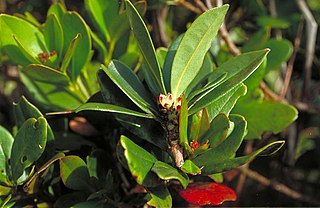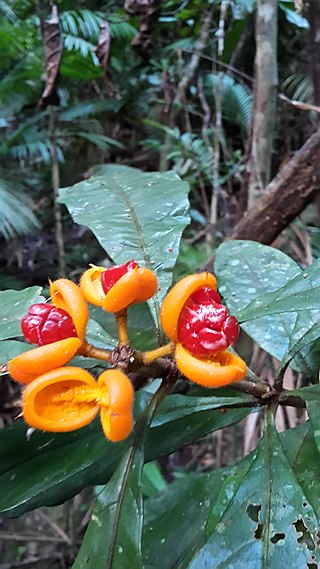
Pittosporum multiflorum, known as the orange thorn, is a shrub growing in eastern Australia. The dense foliage provides a habitat for small birds and animals. It grows on shales or volcanic soils, from Eden, New South Wales north to Queensland, usually in or near rainforest areas.

Gompholobium latifolium, commonly known as golden glory pea or giant wedge-pea, is a flowering plant in the pea family (Fabaceae) and is endemic to eastern Australia. It is a small shrub with leaves composed of three leaflets and which has relatively large yellow flowers in spring and early summer.

Acronychia pubescens, commonly known as hairy acronychia or hairy aspen, is a species of tall shrub or small tree that is endemic to eastern Australia. It usually has trifoliate leaves, rarely simple leaves, groups of whitish flowers in leaf axils and creamy to yellowish, elliptical to spherical fruit.

Pittosporum angustifolium, commonly known as butterbush, weeping pittosporum, berrigan, native willow, native apricot, western pittosporum, apricot tree, bitter bush, cattle bush or poison berry tree, is a weeping shrub or tree that is endemic to mostly inland, continental Australia. It has oblong, linear or narrowly elliptic leaves, fragrant yellow to cream-coloured flowers arranged in leaf axils or on the ends of branches, and oval to spherical, yellowish capsules with dark or orange-red seeds.
Dasymalla glutinosa is a flowering plant in the mint family Lamiaceae and is endemic to Western Australia. It is a spreading, sticky shrub with glabrous branches, egg-shaped, stalkless leaves and small, white or cream-coloured, tube-shaped flowers.

Pityrodia ternifolia is a species of flowering plant in the mint family, Lamiaceae and is endemic to north-western Australia. It is an erect shrub with densely hairy stems, sticky and prickly, egg-shaped leaves, and mauve or pinkish-red, tube-shaped flowers.

Leptospermum barneyense is a species of shrub that is endemic to the Mount Barney National Park in Queensland. It has rough, fibrous bark, young branches with conspicuous flanges, lance-shaped leaves, white or pink flowers and hemispherical fruit.

Medicosma fareana, commonly known as white aspen, is a species of rainforest small tree in the family Rutaceae and is endemic to north Queensland. It has elliptical leaves and white or cream-coloured flowers borne singly or in small groups in leaf axils.

Medicosma glandulosa is a species of shrub or small tree in the family Rutaceae and is endemic to far north Queensland. It has elliptical to egg-shaped leaves and flowers that are white with red tips or cream-coloured, borne singly or in small groups in leaf axils.
Medicosma obovata is a species of shrub or small tree in the family Rutaceae and is endemic to a restricted area of far north Queensland. It has simple egg-shaped leaves with the narrower end towards the base and white flowers borne singly or in small groups in leaf axils.

Medicosma sessiliflora is a species of shrub or small tree in the family Rutaceae and is endemic to far north Queensland. It has simple elliptical to egg-shaped leaves with the narrower end towards the base and cream-coloured flowers borne singly or in small groups in leaf axils.

Hibbertia hexandra, commonly known as tree guinea flower, is a species of flowering plant in the family Dilleniaceae, and is endemic to eastern Australia. It is a tall shrub or small tree with mostly lance-shaped leaves with the narrower end towards the base and yellow flowers arranged singly in leaf axils, with six stamens arranged around two hairy carpels.
Bursaria cayzerae is a species of flowering plant in the family Pittosporaceae and is endemic to the North Coast of New South Wales. It is a sparsely-branched shrub with spiny branches, narrowly elliptic leaves, flowers with five glabrous sepals, spreading white petals and five stamens, and flattened fruit.

Pittosporum ferrugineum, commonly known as the rusty pittosporum or rusty-leaved pittosporum, is an evergreen plant in the family Pittosporaceae native to Malesia, Papuasia, the Northern Territory and Queensland.

Pittosporum rubiginosum, commonly known as hairy red pittosporum, is an evergreen shrub in the family Pittosporaceae which is endemic to northeastern Queensland, Australia. It was first described in 1840.

Marianthus mollis, commonly known as hairy-fruited billardiera, is a species of flowering plant in the family Pittosporaceae and is endemic to a small region in the southwest of Western Australia. It is an erect, spreading, silky-hairy shrub with sessile, egg-shaped leaves and purplish-blue flowers arranged singly in leaf axils.

Pseudanthus ligulatus is a species of flowering plant in the family Picrodendraceae and is endemic to northern Queensland. It is a monoecious shrub with simple, lance-shaped or linear to narrowly oblong leaves and creamy white male and pale green female flowers arranged singly in upper leaf axils, but appearing clustered on the ends of branches.

Micromyrtus littoralis is a species of flowering plant in the myrtle family, Myrtaceae and is endemic to south-eastern Queensland. It is a shrub with small, overlapping egg-shaped to lance-shaped leaves, and small white flowers arranged singly in leaf axils with 5 stamens in each flower.
Micromyrtus patula is a species of flowering plant in the myrtle family, Myrtaceae and is endemic to a small area of south-eastern Queensland. It is a shrub with small, overlapping linear to lance-shaped leaves, and small white flowers arranged singly in leaf axils, usually with 5 stamens in each flower.

Cryptocarya melanocarpa is a species of flowering plant in the family Lauraceae and is endemic to north Queensland. It is a tree with elliptic to oblong to lance-shaped leaves, creamy green, unpleasantly perfumed flowers, and spherical black drupes.

















